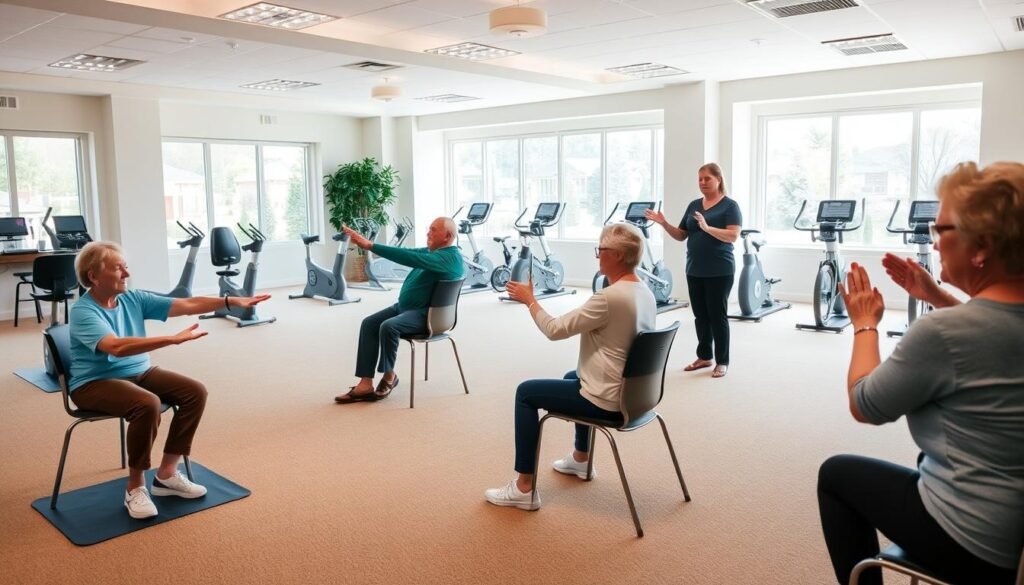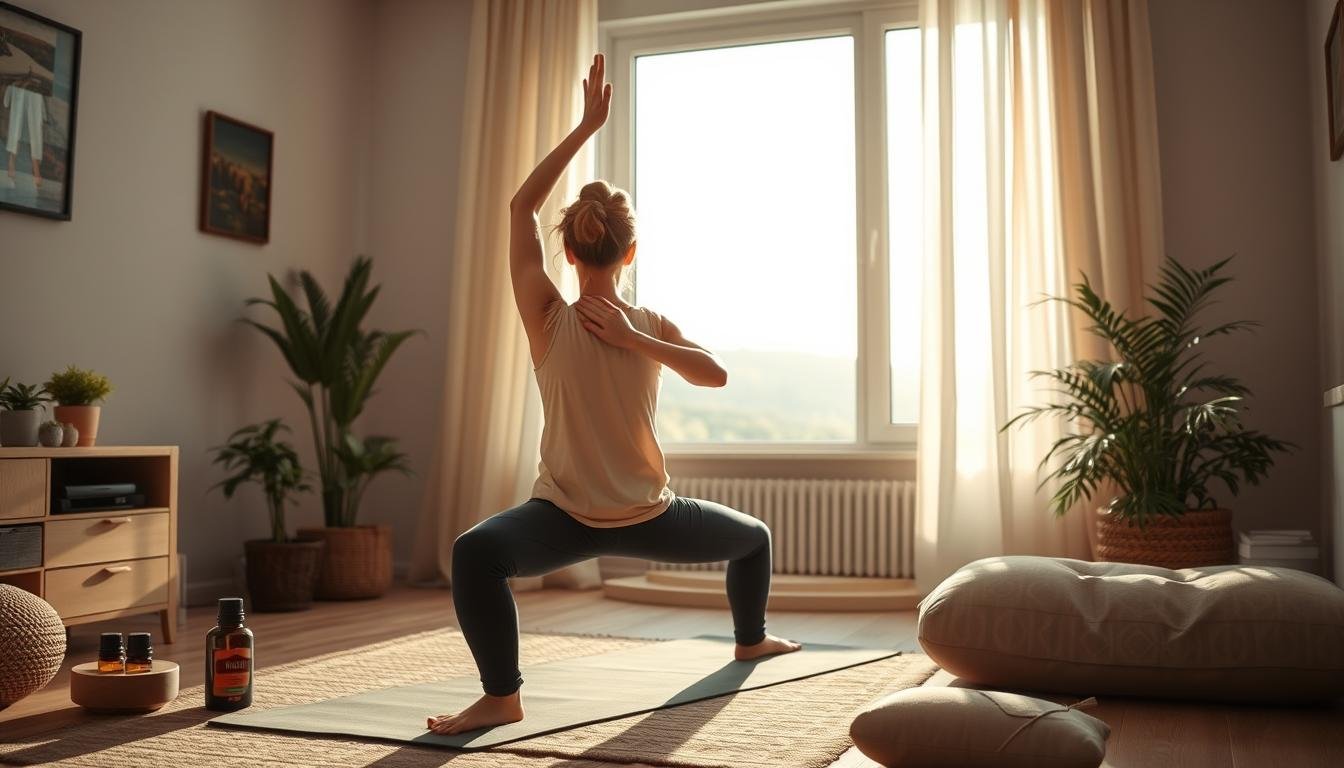Can simple exercises really make a difference in the lives of older adults? As people age, maintaining physical fitness becomes crucial for overall health and independence. The answer lies in low-impact exercises, which are designed to minimize the risk of injury while improving strength, flexibility, and overall well-being.
These exercises are particularly beneficial for older adults, as they promote a better quality of life and reduce the risk of chronic diseases. By incorporating these exercises into their daily routine, seniors can enjoy a more active and healthy lifestyle.
Key Takeaways
- Low-impact exercises improve strength and flexibility in older adults.
- Regular physical activity reduces the risk of chronic diseases.
- Simple exercises can enhance overall well-being and quality of life.
- Incorporating daily exercises promotes a healthier lifestyle.
- Low-impact exercises minimize the risk of injury.
Understanding Senior Fitness and Its Importance
Senior fitness plays a crucial role in ensuring that older adults can lead active, independent lives. As individuals age, their physical health and fitness levels can significantly impact their overall well-being and quality of life.
Regular physical activity is essential for maintaining physical function, reducing the risk of chronic diseases, and enhancing mental health. Despite these benefits, many seniors face challenges in incorporating exercise into their daily routines due to misconceptions about what it means to be fit at an advanced age.
The Benefits of Staying Active in Later Life
Staying active in later life offers numerous benefits, including:
- Improved cardiovascular health
- Enhanced muscular strength and flexibility
- Better balance and coordination
- Reduced risk of falls and injuries
- Improved mental health and cognitive function
These benefits contribute to a more independent and fulfilling life for seniors. Regular exercise can also help manage chronic conditions such as diabetes, hypertension, and heart disease.
Common Misconceptions About Senior Fitness
There are several misconceptions about senior fitness that can deter older adults from engaging in physical activity. Some of these include:
| Misconception | Reality |
|---|---|
| Exercise is too strenuous for seniors. | Many exercises can be modified to suit individual fitness levels, making them accessible for seniors. |
| Senior fitness is only about physical health. | Regular exercise also improves mental health and cognitive function. |
| You need to be flexible to start exercising. | Exercise can help improve flexibility, even in older adults with limited mobility. |
By understanding the importance of senior fitness and dispelling common misconceptions, older adults can take the first step towards a healthier, more active lifestyle.
Key Principles of Safe Workouts for Seniors
Safe and effective exercise for seniors hinges on a few fundamental principles that help prevent injuries and enhance mobility. Understanding these principles is crucial for creating a senior exercise program that is both beneficial and safe.
Listening to Your Body: Knowing Your Limits
One of the most critical aspects of exercising safely as a senior is learning to listen to your body. This means being aware of your physical limits and not pushing yourself too hard, especially if you’re just starting out with a new exercise program. It’s essential to start slowly and gradually increase the intensity and duration of your workouts. This approach helps your body adapt to the new demands you’re placing on it, reducing the risk of strain or injury.
Pain is a signal that something is wrong. If you experience pain during exercise, stop immediately. Consulting with a healthcare professional can help you understand whether the pain is a sign of overexertion or an underlying condition that needs attention.
Avoiding Injury in Low-Impact Exercises
Low-impact exercises, such as brisk walking, swimming, or cycling, are generally recommended for seniors because they minimize the risk of injury. However, even with low-impact activities, it’s crucial to maintain proper form and technique to avoid strain. For example, when walking, wearing supportive shoes and maintaining good posture can help prevent falls and injuries.
Incorporating exercises that improve balance and flexibility can also help prevent falls, a common concern among the elderly. Simple activities like standing on one foot while holding onto a chair for support or doing gentle stretches can significantly enhance your stability and range of motion.
By understanding and applying these key principles, seniors can enjoy the many benefits of regular exercise while minimizing the risks. This balanced approach to fitness is essential for maintaining mobility and enhancing overall quality of life.
Types of Low-Impact Exercises for Seniors
Engaging in low-impact exercises is a safe and effective way for seniors to stay active, healthy, and independent. These exercises are designed to improve overall fitness without putting excessive strain on the body.
Strength Training: Building Muscle Safely
Strength training is a crucial component of any senior fitness routine. It helps maintain muscle mass, supports bone density, and enhances overall physical function. Seniors can engage in strength training using resistance bands or light weights. These tools are not only effective but also easy to use at home.
For example, exercises like bicep curls and shoulder presses can be done with light dumbbells, improving muscle strength without risking injury. It’s essential to start with manageable weights and gradually increase the load as fitness levels improve.
Balance Exercises: Enhancing Stability
Balance exercises are vital for reducing the risk of falls, a common concern among seniors. Activities like tai chi and standing on one foot are excellent for enhancing stability. These exercises improve balance by challenging the body’s equilibrium and strengthening the muscles that support posture.
Simple exercises such as heel-to-toe walking or standing on a balance pad can significantly improve balance and reduce the risk of falls. Practicing these exercises regularly can enhance overall stability and confidence in daily movements.
Flexibility Exercises: Maintaining Range of Motion
Flexibility exercises are essential for maintaining a full range of motion, making daily activities easier and less strenuous. Yoga and simple stretching exercises are highly beneficial for seniors. These activities not only improve flexibility but also promote relaxation and reduce stress.
Examples of flexibility exercises include shoulder stretches, chest stretches, and leg swings. Regularly practicing these exercises can help maintain flexibility, improve posture, and reduce the risk of injury during daily activities.
How to Create a Senior Fitness Routine
A well-structured senior fitness routine can significantly enhance the quality of life for older adults. By incorporating a mix of exercises tailored to their needs, seniors can improve their overall health and maintain independence.
Setting Realistic Goals for Your Fitness Journey
Setting achievable goals is the first step towards creating an effective senior fitness routine. It’s essential to start with manageable objectives, such as exercising for 10-15 minutes a day, and gradually increase the duration and intensity. This approach helps build confidence and reduces the risk of burnout or injury.
Tips for Setting Realistic Goals:
- Begin with short exercise sessions and gradually increase the duration.
- Focus on activities that you enjoy and that suit your fitness level.
- Consult with a healthcare provider or a fitness professional to tailor a routine that meets your individual needs and health status.
Structuring a Weekly Exercise Plan
A well-rounded weekly exercise plan should include a mix of strength training, balance, and flexibility exercises. This variety helps maintain overall fitness and addresses different aspects of physical health.
Sample Weekly Exercise Plan:
| Day | Exercise Type | Duration |
|---|---|---|
| Monday | Strength Training | 20 minutes |
| Tuesday | Balance Exercises | 15 minutes |
| Wednesday | Flexibility Exercises | 20 minutes |
| Thursday | Strength Training | 20 minutes |
| Friday | Balance Exercises | 15 minutes |
| Saturday | Flexibility Exercises | 20 minutes |
By structuring a weekly exercise plan and setting realistic goals, seniors can create a sustainable fitness routine that enhances their overall well-being.
The Role of Mobility in Elderly Health
Mobility is a cornerstone of elderly health, directly influencing the ability to perform daily tasks and maintain independence. As individuals age, various physiological changes can impact mobility, making it a critical aspect of senior care.
Understanding Mobility Challenges for Seniors
Seniors often face mobility challenges due to age-related changes, chronic conditions, or injuries. These challenges can significantly affect their quality of life, leading to decreased independence and increased risk of falls. Common mobility issues include reduced strength, flexibility, and balance.
Factors contributing to mobility challenges in seniors include:
- Muscle atrophy and decreased muscle strength
- Reduced joint flexibility and range of motion
- Balance and coordination issues
- Neurological conditions such as Parkinson’s disease or stroke
Mobility Exercises to Enhance Daily Functioning
Engaging in regular mobility exercises can significantly enhance daily functioning for seniors. Simple exercises such as walking, leg lifts, and stretching can improve strength, flexibility, and balance. These exercises not only help in maintaining independence but also reduce the risk of falls.
Examples of mobility exercises include:
- Walking or short-distance jogging
- Seated leg lifts and toe raises
- Arm raises and shoulder rolls
- Simple stretching exercises for major muscle groups
By incorporating these exercises into their daily routine, seniors can improve their mobility, enhance their overall health, and maintain their independence.
Incorporating Low-Impact Exercises into Daily Life
Embracing low-impact exercises as part of daily life can lead to improved health outcomes for seniors. By incorporating simple and safe workouts into their routines, seniors can enhance their mobility, strength, and overall well-being.
Examples of Gentle Exercises You Can Do at Home
There are numerous low-impact exercises that seniors can do from the comfort of their own homes. These include:
- Chair yoga: A gentle form of yoga that can be modified to suit individual needs.
- Wall push-ups: A safe way to build upper body strength.
- Seated marching: An exercise that can help improve leg strength and mobility.
These exercises are not only easy to follow but also reduce the risk of injury, making them ideal for seniors.

Finding Community Resources for Senior Fitness
Many communities offer resources and programs designed to support senior fitness. These can include:
| Resource | Description | Benefits |
|---|---|---|
| Group Exercise Classes | Classes tailored for seniors, focusing on low-impact exercises. | Social interaction, guided instruction. |
| Walking Clubs | Organized walking groups that encourage regular physical activity. | Improved cardiovascular health, social benefits. |
| Senior Fitness Programs | Comprehensive programs designed to meet the fitness needs of seniors. | Varied exercises, support from instructors. |
Utilizing these community resources can provide seniors with the motivation and support needed to maintain a consistent exercise routine.
The Importance of Warm-Up and Cool-Down
Incorporating warm-up and cool-down exercises into senior fitness programs can significantly enhance overall well-being. As people age, their bodies undergo various changes that can affect their flexibility, balance, and overall physical fitness. A well-structured warm-up prepares the body for physical activity, while a cool-down helps in recovery.
Effective Warm-Up Techniques for Seniors
A good warm-up is essential for seniors to prevent injuries and ensure they get the most out of their workout. Effective warm-up techniques include:
- Light cardio such as walking or swimming
- Dynamic stretching to improve flexibility
- Mobility exercises to enhance range of motion
Example Warm-Up Routine: A 5-10 minute routine could include marching in place, arm circles, and leg swings. This helps increase blood flow to the muscles and prepares the cardiovascular system for more intense activity.
Cool-Down Stretches to Enhance Recovery
Cool-down stretches are crucial for seniors as they help in reducing muscle soreness and improving flexibility. Some effective cool-down stretches include:
| Stretch | Muscle Group | Duration |
|---|---|---|
| Neck Stretch | Neck | 30 seconds |
| Shoulder Rolls | Shoulders | 30 seconds |
| Hamstring Stretch | Hamstrings | 30 seconds per leg |
By incorporating these warm-up and cool-down techniques into their senior workout routines, seniors can significantly reduce the risk of injury and enhance their overall fitness journey.
Monitoring Your Progress Safely
For seniors, monitoring progress safely is essential to ensure they are moving towards their fitness goals without risking injury. Regular tracking not only helps in identifying areas of improvement but also in making necessary adjustments to the exercise routine.
Keeping Track of Your Fitness Journey
Keeping a record of your workouts and progress can be highly motivating. Using a fitness journal or a mobile app designed for seniors can simplify this process. These tools allow you to log your exercises, track your progress, and set reminders for future workouts.
Some popular methods for tracking fitness include:
- Using a pedometer to track daily steps
- Logging workout sessions in a journal
- Utilizing mobile apps designed for senior fitness
![]()
“Monitoring progress is not just about achieving fitness goals; it’s about maintaining a healthy and active lifestyle.”
This mindset is crucial for seniors as it encourages a long-term commitment to their well-being.
When to Seek Professional Guidance
While exercising at home or in a community setting can be beneficial, there are times when professional guidance is necessary. If you experience pain or discomfort during exercise, it’s crucial to stop and consult with a healthcare provider or a fitness professional.
| Situation | Action |
|---|---|
| Experiencing pain during exercise | Stop and consult a healthcare provider |
| Noticing significant changes in health | Consult a healthcare provider before continuing exercise |
| Needing personalized fitness advice | Consult a fitness professional specializing in geriatric fitness |
By monitoring your progress safely and seeking professional guidance when needed, you can enjoy a more effective and safe geriatric fitness journey. This proactive approach to senior wellness practices not only enhances your physical health but also contributes to a more fulfilling life.
Nutrition and Hydration for Active Seniors
Proper nutrition and hydration are crucial for seniors who are active and want to maintain their health and fitness. As people age, their bodies undergo various changes that affect their nutritional needs and ability to stay hydrated.
Importance of Proper Nutrition in Senior Fitness
A well-balanced diet is essential for seniors who participate in low-impact exercises to maintain their overall well-being. Nutrition plays a vital role in supporting muscle health, bone density, and energy levels. Seniors should focus on consuming a variety of foods rich in nutrients, including:
- Fruits and vegetables, which provide essential vitamins and minerals
- Whole grains, which offer fiber and B vitamins
- Lean proteins, which are crucial for muscle maintenance and repair
It’s also important for seniors to be mindful of their calorie intake, ensuring they’re consuming enough to support their energy needs without overeating.
Tips for Staying Hydrated During Workouts
Staying hydrated is equally important for seniors who exercise regularly. Dehydration can lead to serious health issues, including dizziness, confusion, and even hospitalization. Here are some tips for seniors to stay hydrated:
- Drink water before, during, and after exercise to maintain fluid levels
- Incorporate hydrating foods into their diet, such as watermelon and cucumbers
- Monitor their urine output to ensure it’s pale yellow or clear, indicating proper hydration
By focusing on proper nutrition and hydration, seniors can support their fitness goals and maintain their overall health and well-being.
Success Stories: Inspiring Senior Fitness Journeys
Inspiring stories from seniors who have benefited from regular physical activity demonstrate the power of exercise in later life. Many have not only improved their physical health but have also experienced a significant boost in their mental wellbeing.
Real-Life Examples of Seniors Who Thrive
There are numerous examples of seniors who have transformed their lives through exercise. For instance, a 75-year-old grandmother who started with short walks and gradually incorporated strength training was able to regain her strength and mobility, allowing her to continue enjoying activities with her family.
Another inspiring story is of a senior who, after being diagnosed with a chronic condition, began a tailored exercise program. Through safe workouts, he was able to manage his condition effectively and improve his overall health.
Motivation from Fitness Coaches and Experts
Fitness coaches and experts play a crucial role in motivating seniors to start and maintain their fitness journeys. They provide personalized guidance and support, helping seniors to set realistic goals and achieve them.
Experts emphasize the importance of elderly health and the role that regular exercise plays in maintaining it. By focusing on low-impact exercises and gradual progression, seniors can enjoy the benefits of physical activity while minimizing the risk of injury.
Through the combination of inspiring success stories and expert guidance, it’s clear that regular exercise can have a profound impact on the lives of seniors, enhancing their health, wellbeing, and overall quality of life.
Conclusion: Embracing a Healthier Lifestyle
Regular exercise can significantly enhance the quality of life for seniors, promoting mobility and supporting overall health. By incorporating low-impact exercises into their daily routine, seniors can enjoy improved physical and mental well-being.
Lifelong Benefits of Exercise
Engaging in senior exercise programs can lead to numerous lifelong benefits, including enhanced mobility, reduced risk of chronic diseases, and a greater sense of independence. These programs are designed to be safe and accessible, allowing seniors to stay active and healthy.
Starting an Active Routine
Seniors can start their fitness journey today by exploring gentle exercises that suit their needs and abilities. With the right guidance and support, they can achieve a healthier, more active lifestyle, enjoying the many rewards that come with regular physical activity.



